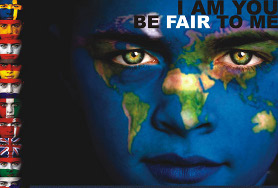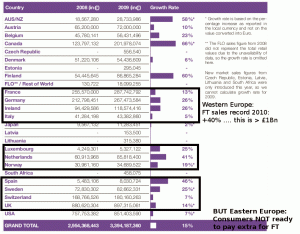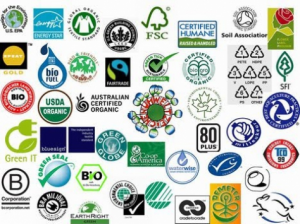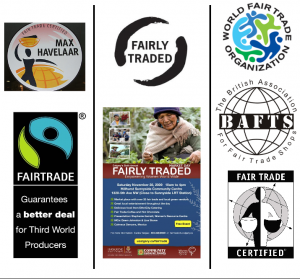 The recognition of fair trade (or Fairtrade – depending on what organisation and certification we’re talking about) varies by geographical location. So far nothing new there. It however gets slightly more interesting, if we cross said insights, available from the FLO 2009/10 annual report, with what we can observe of what happens on a political and strategical level. In this post, I’ll be summarising my own insights – please do add your own by leaving a comment!
The recognition of fair trade (or Fairtrade – depending on what organisation and certification we’re talking about) varies by geographical location. So far nothing new there. It however gets slightly more interesting, if we cross said insights, available from the FLO 2009/10 annual report, with what we can observe of what happens on a political and strategical level. In this post, I’ll be summarising my own insights – please do add your own by leaving a comment!
I make this a 2 post series again. In this week’s post, I want to look at what the stats tell us about different markets, consumer awareness, and what that means for FT in the near future. This analysis is not exclusively related to fashion at all – quite to the contrary – but it does tell us a lot about the perception of ‘ethical’ goods in the various geographical markets.
This first post is based on what we actually already know – at least informally.
The second post will be looking at trends that we can infer from what is happening in the global markets.
Old news: When it comes to Fairtrade, Europe is divided.

- Western Europe is overall leading as far as retail sales of FT products is concerned, notably considering that we’re looking at a consistent picture across the majority of the EU.
- The UK is by far and distance the market leader. This may notably have a direct correlation with – at least to my knowledge – that there is not a single country where retailers have very commonly created in-house brands that are FT certified. E.g. Sainsbury’s own FT certified tea or coffee.
- There is a North/South divide in Europe: As we go North, sales of Fairtrade products increase, the further we go South the more irrelevant the numbers are in relation to the total market size.
High growth rates in these areas invariably are the result of low base line volumes. - Eastern Europe is entirely uninterested in the whole FT discussion, and does not buy into this idea (yet). Consumers in these countries still decide based on price as the single most important decision criteria.
- The US and Canada are lagging considerable at least when compared to their overall population. Canada is doing much better than the US, however, relatively speaking.
- Australia & New Zealand are late starters, but it seems FT is gaining ground rapidly in these areas.
Old news continued: A label jungle confuses customers: It undermines their individual effectiveness and their impact on the overall market.
Sadly, with the split of Fair Trade USA (formerly TransFair USA) – the first organisation with a fashion specific manufacturing certification standard – from FLO as per 1st of January 2012, the label chaos has gained unwanted momentum. As it seems, while FLO credentials will still be accepted by Fair Trade USA, they will work with a different third party audit organisation, and define standards that – according to their own statement – FLO so far did not want or was not able to tackle.
The two big issues in this context have to do with the ultimate marketability of the goods. Clear, identifiable and well recognisable labelling makes it easy to shop, but also raises awareness of consumers as to what they’ve just put into their shopping cart.
Unclear, confusing labelling however, does exactly the opposite … and devalues any certification on the mid- to long-term, and minimises their total market impact.


- [left] Abundance of ‘ethical’ labels, certifications and accreditations
The illustration is saying plenty already, but in fact, do you know the difference between Fairtrade certified and Rainforest Alliance certified? Well – then how is the mainstream consumer to know and to trust?
In fact, I remember the results of some research, that – for the case of tea and coffee – proved that consumers on the high street were not able to distinguish between the mentioned two labels. But surely it isn’t the only 2 that get jumpled together: other examples would be for example: EcoTex cotton vs. Fairtrade cotton; or organic certified vs. Blue Angel sign to just name a few. - [right] Fairtrade vs. ‘fairly trade’ vs. fair trade
This point is an extension of the previous one: three different terms, multiple certification authorities, the fact that ‘Fairtrade’ is trade marked but ‘fair trade’ (in two words) isn’t, and then the fact that anyone can claim to offer ‘fairly traded’ goods without giving the term any particular meaning. How are the consumers to trust or distinguish between the different aspects? Notably, when it is more than known that neither FLO nor WFTO certification/accreditation is a guarantor for ethical practises (ask me personally: I can give a couple of examples), but just makes it less probable that blatant misconduct is happening – would is the consumer to believe, after all?
So far what we actually know anyway. The trend we see is that the lack of transparency of individual certification authorities – after all self-audits are more common than suitable – is suffering in the eyes of the consumers. They are, in principle, willing to buy into the idea of Fairtrade (or fair trade), but the issue of trust is absolutely pivotal. And with every addition label and certification authority popping up, trust is decreasing and the accusation of monetary greed in these organisations gains probability. It goes without saying that none of this is doing much good to the bigger cause.
The 2nd part of this article series will be look more into what we can infer from what is happening ‘out there’ in the general, global market place.

